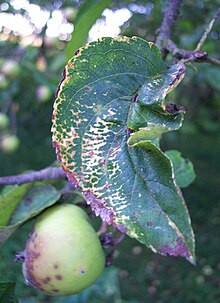Ilarvirus
Ilarvirus is a genus of viruses, in the family Bromoviridae. Plants serve as natural hosts. There are currently 19 species in this genus including the type species Tobacco streak virus.[2][3]
Structure
Viruses in Ilarvirus are non-enveloped, with icosahedral and Quasi-spherical geometries, and T=3 symmetry. The diameter is around 29 nm. Genomes are linear and segmented, tripartite.[2]
| Genus | Structure | Symmetry | Capsid | Genomic arrangement | Genomic segmentation |
|---|---|---|---|---|---|
| Ilarvirus | Icosahedral | T=3 | Non-enveloped | Linear | Segmented |
Life cycle
Viral replication is cytoplasmic, and is lysogenic. Entry into the host cell is achieved by penetration into the host cell. Replication follows the positive stranded RNA virus replication model. Positive stranded rna virus transcription, using the internal initiation model of subgenomic rna transcription is the method of transcription. The virus exits the host cell by tubule-guided viral movement. Plants serve as the natural host. Transmission routes are mechanical and contact.[2]
| Genus | Host details | Tissue tropism | Entry details | Release details | Replication site | Assembly site | Transmission |
|---|---|---|---|---|---|---|---|
| Ilarvirus | Plants | None | Viral movement; mechanical inoculation | Viral movement | Cytoplasm | Cytoplasm | Mechanical inoculation: insects; contact |
References
- ^ "Virus Taxonomy: 2017 Release" (HTML). International Committee on Taxonomy of Viruses. July 2017. Retrieved 30 August 2018.
- ^ a b c "Viral Zone". ExPASy. Retrieved 15 June 2015.
- ^ ICTV. "Virus Taxonomy: 2014 Release". Retrieved 15 June 2015.

